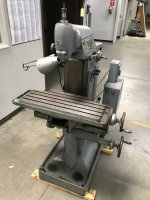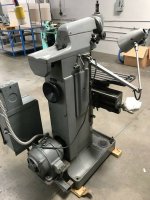good evening
firstly my apologies for not posting much and being an active member,
I admit I'm more of a taker on this site... but at least I'm honest :-)
part of it is I don't have much knowledge to contribute...
with that said, I'm looking for some assistance -
my background is in manufacturing operations management, I was a CAD/CAM engineer, and have managed CNC aerospace machine shops, but I'm not a machinist.
I'm a part time knife maker blade smith going full-time. The first machine I bought was a Burke Millrite MVN with DRO and power feed. It was a excellent and it hurt to sell especially since I got it for $800 delivered.
anyway, I'm setting up my new shop and came across a local Deckel. I went and looked at it today and it will be put under power for me this weekend. I will run it with a phase convertor since I don't have 3 phase,
I asked two machinists I know and they both said these are extremely high quality machines and good for short run production and versatility.
my use of the mill on knife making is actually very little but I like good quality equipment if I can. I mill slots, cut grooves, some face milling etc. But I prefer to overbuy if I can and have more capability than I need. A mill is handy for slip joint folders
these pics are from the seller's ad.
I'm attracted by the smaller size and table layout
my question is how is this FP1 different than your standard Bridgeport style mill (in terms of practical use) and what does the higher price offer me? And if you can lay any other knowledge on me it's most appreciated.
more questions -
Does the vertical spindle head move out of the way to use the horizontal spindle? Does the horizontal use the same collets? To move the ram back and forth, is there some geared mechanism?
What is the purpose of the black wheel in the back?
regards
Harbeer




firstly my apologies for not posting much and being an active member,
I admit I'm more of a taker on this site... but at least I'm honest :-)
part of it is I don't have much knowledge to contribute...
with that said, I'm looking for some assistance -
my background is in manufacturing operations management, I was a CAD/CAM engineer, and have managed CNC aerospace machine shops, but I'm not a machinist.
I'm a part time knife maker blade smith going full-time. The first machine I bought was a Burke Millrite MVN with DRO and power feed. It was a excellent and it hurt to sell especially since I got it for $800 delivered.
anyway, I'm setting up my new shop and came across a local Deckel. I went and looked at it today and it will be put under power for me this weekend. I will run it with a phase convertor since I don't have 3 phase,
I asked two machinists I know and they both said these are extremely high quality machines and good for short run production and versatility.
my use of the mill on knife making is actually very little but I like good quality equipment if I can. I mill slots, cut grooves, some face milling etc. But I prefer to overbuy if I can and have more capability than I need. A mill is handy for slip joint folders
these pics are from the seller's ad.
I'm attracted by the smaller size and table layout
my question is how is this FP1 different than your standard Bridgeport style mill (in terms of practical use) and what does the higher price offer me? And if you can lay any other knowledge on me it's most appreciated.
more questions -
Does the vertical spindle head move out of the way to use the horizontal spindle? Does the horizontal use the same collets? To move the ram back and forth, is there some geared mechanism?
What is the purpose of the black wheel in the back?
regards
Harbeer









